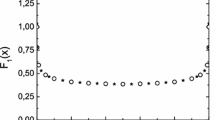Abstract
A simple model of Bose–Einstein condensation of interacting particles is proposed. It is shown that in the condensate state the dependence of thermodynamic quantities on the interaction constant does not allow an expansion in powers of the coupling constant. Therefore, it is impossible to pass to the Einstein model of condensation in an ideal Bose gas by means of a limiting passage, setting the interaction constant to zero. The account for the interaction between particles eliminates difficulties in the description of condensation available in the model of an ideal gas, which are connected with the fulfillment of thermodynamic relations and an infinite value of the particle number fluctuation in the condensate phase.




Similar content being viewed by others
References
S.N. Bose, Plancks Gesetz und Lichtquanten-Hypothese. Z. Phys. 26, 178–181 (1924)
A. Einstein, Quantum theory of the monatomic ideal gas. Sitzungsberichte der Preussischen Akademie der Wissenschaften, Physikalisch-mathematische Klasse 261–267 (1924)
A. Einstein, Quantum theory of the monatomic ideal gas. Sitzungsberichte der Preussischen Akademie der Wissenschaften, Physikalisch-mathematische Klasse 3–14 (1925)
A. Einstein, A Collection of Scientific Works, vol. 3 (Nauka, Moscow, 1966), pp. 481–511
F. London, The \(\lambda \)-phenomenon of liquid helium and the Bose–Einstein degeneracy. Nature 141, 643 (1938)
L. Tisza, Transport phenomena in helium II. Nature 141, 913 (1938)
P.L. Kapitsa, Viscosity of liquid helium below the \(\lambda \)-point. Nature 141, 74 (1938)
J.F. Allen, H. Jones, New phenomena connected with heat flow in helium II. Nature 141, 234 (1938)
L. Pitaevskii, S. Stringari, Bose–Einstein Condensation (Oxford University Press, New York, 2003)
C.H. Pethick, H. Smith, Bose–Einstein Condensation in Dilute Gases (Cambridge University Press, New York, 2002)
L.P. Pitaevskii, Bose–Einstein condensates in a laser radiation field. Phys. Usp. 49, 333–351 (2006)
N.N. Bogolyubov, On the theory of superfluidity. J. Phys. USSR 11, 23–32 (1947)
N.N. Bogolyubov, On the theory of superfluidity. Izv. Akad. Nauk. SSSR Ser. Fiz. 11, 77–90 (1947)
E.P. Gross, Structure of a quantized vortex in boson systems. IL Nuovo Cimento 20, 454–477 (1961)
L.P. Pitaevskii, Vortex lines in an imperfect Bose gas. Sov. Phys. JETP 13, 451–454 (1961)
Yu.M. Poluektov, Isobaric heat capacity of an ideal Bose gas. Russ. Phys. J. 44(6), 627–630 (2001)
L.D. Landau, E.M. Lifshitz, Statistical Physics, vol. 5 (Butterworth-Heinemann, Oxford, 1980)
Yu.M. Poluektov, Self-consistent field model for spatially inhomogeneous Bose systems. Low Temp. Phys. 28, 429–441 (2002)
Yu.M. Poluektov, On the quantum-field description of many-particle Bose systems with spontaneously broken symmetry. Ukr. J. Phys. 52(6), 579–595 (2007). arXiv:1306.2103 [cond-mat.stat-mech]
S.T. Beliaev, Application of the methods of quantum field theory to a system of bosons. Sov. Phys. JETP 7, 289–299 (1958)
N.M. Hugenholtz, D. Pines, Ground-state energy and excitation spectrum of a system of interacting bosons. Phys. Rev. 116, 489–506 (1959)
M. Buckingham, W. Fairbank, The nature of lambda-transition in liquid helium. Prog. Low Temp. Phys. 3, 80–112 (1961)
K. Huang, Statistical Mechanics (Wiley, London, 1987)
V.I. Yukalov, Fluctuations of composite observables and stability of statistical systems. Phys. Rev. E 72, 066119 (2005)
V.I. Yukalov, Modified semiclassical approximation for trapped Bose gases. Phys. Rev. A 72, 033608 (2005)
P.G. de Gennes, Superconductivity of Metals and Alloys (Benjamin, New York, 1966)
Author information
Authors and Affiliations
Corresponding author
Rights and permissions
About this article
Cite this article
Poluektov, Y.M. A Simple Model of Bose–Einstein Condensation of Interacting Particles. J Low Temp Phys 186, 347–362 (2017). https://doi.org/10.1007/s10909-016-1715-5
Received:
Accepted:
Published:
Issue Date:
DOI: https://doi.org/10.1007/s10909-016-1715-5



